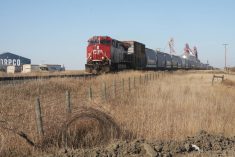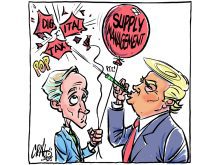Ford had a problem with the F-150.
It had been the most popular truck in America for decades, but it was the oldest design.
Market share was starting to erode with the entry of full-sized Japanese pickups.
How do you introduce a new truck without damaging brand loyalty?
Enter the 2004 F-150, all new with the latest in technology, but it still looks like a Ford from all angles.
My test truck came hot off the assembly line as a fully equipped, four door Lariat Super Crew with four-wheel drive.
Read Also

Agriculture needs to prepare for government spending cuts
As government makes necessary cuts to spending, what can be reduced or restructured in the budgets for agriculture?
When I looked at the front end, I could see it was different, but it could have been just a new fascia on the old body. When I started my walk around, every panel looked similar, but all were different than last year. The truck box seemed higher and the bulges around the wheel wells gave a new definition to the sides.
Inside, you can still get the plain interior, but at the Lariat level, you can order power-actuated, leather-faced seats with heaters. The pedals can move fore or aft about 20 centimetres. The front passenger has the same power seat as the driver.
Even in the back seat of this Super Crew model, you aren’t hard done by. The bench seat has a centre fold-down arm rest and a fixed back rest. You also have to make do with the optional DVD-based entertainment system rather than listening to your own tunes on the main stereo.
Instrumentation is clear and easy to see, although at night there is some glare reflected onto the front window if the lights are up too high. All switches and controls fall readily to hand and for the most part can be worked with gloves on. The stereo system has a CD player and the sound quality will rival many home units.
Window and door lock controls have been moved so your parka sleeve will no longer cause the door locks to open and close randomly, scaring you half to death.
The gear shift took a little time to get used to. Going from park to drive is easy, but on occasion I pulled the lever back into second instead of drive. Those second gear starts were sluggish and required plenty of throttle. The next time I would hit drive, the transmission would drop to first gear, and I’d shoot to the moon using the same amount of throttle. I suspected a gremlin in the electronics until a friend asked why I was starting in second gear when there wasn’t any ice close by. The power went to the light bulb and my problem was solved with a little more attention to my shifting.
The new 5.4 litre Triton V8 has three valves per cylinder and a single overhead camshaft. Ford has redone the electronic engine and transmission controls for improved fuel economy and power over the previous 5.4 Triton engine.
Speed costly
Concerns with fuel economy arose when the fuel consumption display showed I was getting better mileage in town than on the highway. Could the gauge be wrong? No, it was the heavy foot of the driver.
It would appear that having the extra 4X4 gear does carry a penalty in fuel economy. The new F-150 is sensitive to speed. If I travelled at 90 km-h, fuel economy was close to what I was told to expect. Bumping the speed up to 100 km-h added about two litres per 100 kilometres to consumption. Hitting 110 km-h added another two and if I scooted along at 120 km-h, mileage plummeted. This meant using the cruise control wherever I went because the ride is so smooth and quiet that you don’t get much sensation of speed.
Ride quality has taken a big leap forward in the new 150. Ford has gone to a combination of suspensions. Double wishbones form the basis, but the shocks have coil springs over them, similar to but not the same as what would be found in MacPherson struts. Improvements in control and steering are amplified by the improved rigidity of the chassis that these pieces get hung on.
Rear suspension changes are simple yet revolutionary. A solid rear axle still has coil springs, trailing arms and shocks, but shock location improves ride. Shocks used to be put inside the frame rails under the pick-up bed to keep them out of the way. Today, Ford has moved the shocks to the outside of the frame rails, as close to the wheel as possible. This gives the maximum amount of control at each wheel with the least amount of interference at the other side of the axle. In effect, the solid axle begins to act like an independent one on poor road surfaces.
Driving down a gravel road is now just a relaxing jaunt. If you come upon a washboard section, you still know it, but the tail doesn’t step out.
My friends called my test Lariat a city truck, but I didn’t notice any of them turning me down when I offered to let them drive.
It looks like Ford may have done what it said it was going to do: lift up the rad cap and slide a new truck underneath.
Charles Renny is a freelance automotive columnist and a member of the Automobile Journalists Association of Canada. The opinions expressed in this column are the personal views of the writer.
















